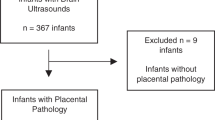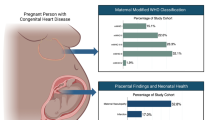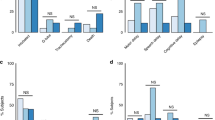Abstract
Objective
Placental abruption can cause maternal blood loss and maternal anemia. It is less certain whether abruption can cause fetal blood loss and neonatal anemia.
Study design
Retrospective multi-hospital 24-month analysis of women with placental abruption and their neonates.
Results
Of 55,111 births, 678 (1.2%) had confirmed abruption; 83% of these neonates (564) had one or more hemoglobins recorded in the first day. Four-hundred-seventy (83.3%) had a normal hemoglobin (≥5th% reference interval) while 94 (16.7%) had anemia, relative risk 3.26 (95% CI, 2.66–4.01) vs. >360,000 neonates from previous reference interval reports. The relative risk of severe anemia (<1st% interval) was 4.96 (3.44–7.16). When the obstetrician identified the abruption as “small” or “marginal” the risk of anemia was insignificant.
Conclusions
Most abruptions do not cause neonatal anemia but approximately 16% do. If an abruption is not documented as small, it is important to surveille the neonate for anemia.
This is a preview of subscription content, access via your institution
Access options
Subscribe to this journal
Receive 12 print issues and online access
$259.00 per year
only $21.58 per issue
Buy this article
- Purchase on Springer Link
- Instant access to full article PDF
Prices may be subject to local taxes which are calculated during checkout



Similar content being viewed by others

References
Tikkanen M. Placental abruption: epidemiology, risk factors and consequences. Acta Obstet Gynecol Scand. 2011;90:140–9.
Ananth CV, Oyelese Y, Yeo L, Pradhan A, Vintzileos AM. Placental abruption in the United States, 1979 through 2001: temporal trends and potential determinants. Am J Obstet Gynecol 2005;192:191–8.
Hall DR. Abruptio placentae and disseminated intravascular coagulopathy. Semin Perinatol. 2009;33:189–95.
Downes KL, Grantz KL, Shenassa ED. Maternal, labor, delivery, and perinatal outcomes associated with placental abruption: a systematic review. Am J Perinatol. 2017;34:935–57.
Golditch IM, Boyce NE. Management of abruptio placentae. JAMA. 1970;212:288–93.
Bruinsma MAW, de Boer MA, Prins S, Abheiden CNH. Does placental abruption cause neonatal anemia? Acta Obstet Gynecol Scand. 2022;101:917–22.
Aher S, Malwatkar K, Kadam S. Neonatal anemia. Semin Fetal Neonatal Med. 2008;13:239–47.
Lokeshwar MR, Singhal T, Shah N. Anemia in the newborn. Indian J Pediatr. 2003;70:893–902.
Stroustrup A, Trasande L. Demographics, clinical characteristics, and outcomes of neonates diagnosed with fetomaternal hemorrhage. Arch Dis Child Fetal Neonatal Ed. 2012;97:F405–10.
Umazume T, Yamada T, Morikawa M, Ishikawa S, Kojima T, Cho K, et al. Occult fetomaternal hemorrhage in women with pathological placenta with respect to permeability. J Obstet Gynaecol Res. 2016;42:632–9.
Yin X, Chen Z, Yang L, Shao Q, Chen C, Feng Z. Coagulation function and placental pathology in neonates with placental abruption. Int J Clin Exp Pathol. 2018;11:604–13.
Carr NR, Henry E, Bahr TM, Ohls RK, Page JM, Ilstrup SJ, et al. Fetomaternal hemorrhage: Evidence from a multihospital healthcare system that up to 40% of severe cases are missed. Transfus (Paris). 2022;62:60–70.
Maternal mortality [Internet]. [cited 2022 Nov 2]. Available from: https://www.who.int/news-room/fact-sheets/detail/maternal-mortality.
Acun C, Karnati S, Padiyar S, Puthuraya S, Aly H, Mohamed M. Trends of neonatal hypoxic-ischemic encephalopathy prevalence and associated risk factors in the United States, 2010 to 2018. Am J Obstet Gynecol. 2022;S0002-9378:00443–4.
Parc E, Benin A, Lecarpentier E, Goffinet F, Lepercq J. Risk factors for hypoxic-ischemic encephalopathy or neonatal death in placental abruption. J Gynecol Obstet Hum Reprod. 2023;52:102498.
Bahr TM, Lawrence SM, Henry E, Ohls RK, Li S, Christensen RD. Severe anemia at birth—incidence and implications. J Pediatr. 2022;248:e2.
Henry E, Christensen RD. Reference intervals in neonatal hematology. Clin Perinatol. 2015;42:483–97.
Christensen, RD, Ohls, RK Anemias unique to the fetus and neonate. In: Wintrobe’s Clinical Hematology. Wolters Kluwer; 2019. p. 1039.
Acknowledgements
We thank Jillyn Spencer, Office of Research, Intermountain Healthcare, for her expert interactions with the Intermountain Healthcare Institutional Review Board. We also thank Michael W. Varner, MD, Maternal-Fetal Medicine, University of Utah and Stephen D. Minton, MD, Neonatology, Intermountain Healthcare for very helpful discussions.
Author information
Authors and Affiliations
Contributions
SMT: Conception and design, collection and assembly of data, data analysis and interpretation, manuscript writing, final approval of manuscript. TMB: Data analysis and interpretation, manuscript writing, final approval of manuscript. EH: Collection and assembly of data, manuscript writing, final approval of manuscript. JMP: Collection and assembly of data, manuscript writing, final approval of manuscript. SJI: Collection and assembly of data, data analysis and interpretation, manuscript writing, final approval of manuscript. RKO: Data analysis and interpretation, manuscript writing, final approval of manuscript. RDC: Conception and design, collection and assembly of data, data analysis and interpretation, manuscript writing, final approval of manuscript.
Corresponding author
Ethics declarations
Competing interests
The authors declare no competing interests.
Additional information
Publisher’s note Springer Nature remains neutral with regard to jurisdictional claims in published maps and institutional affiliations.
Rights and permissions
Springer Nature or its licensor (e.g. a society or other partner) holds exclusive rights to this article under a publishing agreement with the author(s) or other rightsholder(s); author self-archiving of the accepted manuscript version of this article is solely governed by the terms of such publishing agreement and applicable law.
About this article
Cite this article
Tweddell, S.M., Bahr, T.M., Henry, E. et al. Placental abruption and neonatal anemia. J Perinatol 43, 782–786 (2023). https://doi.org/10.1038/s41372-023-01603-w
Received:
Revised:
Accepted:
Published:
Issue Date:
DOI: https://doi.org/10.1038/s41372-023-01603-w


